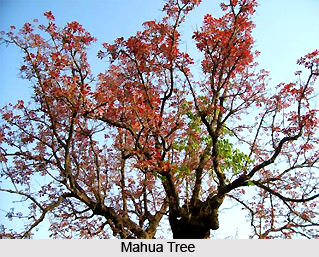 Mahua, an Indian medicinal plant, is widely used in the country for a number of curative and healing purposes. Sapotaceae Madhuca indica is the scientific name of this medicinal plant. There are several common names for Mahua that are used in different parts of the country. Other common names of Mahua in Hindi language are mauwa, mohua and mohwa. In Bengali language, it is known as banmahuva, mahula, mahwa and maul; in English, its names are butter tree and mahua tree. In Gujarati, Mahua is also known as mahuda and mahura; in Kannada, it is known as doddippe. hallippa, hippe mara, ippi and kadippe. In Marathi language, it is known as mahwa and moh, in Oriya, madgi, mahula, moha, moholo and mohuka; and in Sanskrit it is known as madhuka and madhukah and in Urdu this medicinal plant is known as mahuva.
Mahua, an Indian medicinal plant, is widely used in the country for a number of curative and healing purposes. Sapotaceae Madhuca indica is the scientific name of this medicinal plant. There are several common names for Mahua that are used in different parts of the country. Other common names of Mahua in Hindi language are mauwa, mohua and mohwa. In Bengali language, it is known as banmahuva, mahula, mahwa and maul; in English, its names are butter tree and mahua tree. In Gujarati, Mahua is also known as mahuda and mahura; in Kannada, it is known as doddippe. hallippa, hippe mara, ippi and kadippe. In Marathi language, it is known as mahwa and moh, in Oriya, madgi, mahula, moha, moholo and mohuka; and in Sanskrit it is known as madhuka and madhukah and in Urdu this medicinal plant is known as mahuva.
Mahua is native to India, Sri Lanka and also Myanmar (Burma). It is found in mixed, more typically dry, deciduous forests throughout most of India to an altitude of 1200 metres. It is extensively planted in the plains of northern and peninsular India.
Mahua is a medium sized to large deciduous tree, usually 12 to 15 metres tall, with a short trunk and large rounded crown; its bark is either dark brown or black, cracked; inner bark dark red, milky. Leaves of this plant are clustered near the ends of stout branches, broadly elliptic, coriaceous, crimson and pubescent when young. They are almost glabrous when mature, 5 to 25 cm long and 3.5 to 12 cm wide, apex shortly acuminate, base rounded to cuneate; main nerves 9 to 14 pairs, prominent beneath; petioles 2 to 4 cm long; with stipules 0.6 to 1 cm long, subulate and densely pubescent. This plant has numerous flowers, scented, clustered on leafless shoots; with pedicels 2.5 to 4 cm long, densely rusty-pubescent; calyx 1.6 cm long, sepals elliptic, ovate-lanceolate or obovate, around 9 to 10 mm long and 8 to 10 mm wide, acute, both inner and outer rusty-pubescent; have creamy white corolla, around 1.3 cm long, with 8 mm long tube, lobes narrowly obovate-oblong, rounded and densely hairy below. Fruits (berries) are ovoid or sub-globose, generally 2.5 to 5 cm long, greenish in colour but they turn reddish-yellow or orange when ripe, are fleshy; with few seeds. Its flowers appear with new leaves in between February and April and fruits ripening begin from May to August in northern and central India.
Mahua has several medicinal properties and uses. The seed oil has emollient properties and is useful for external application in treating skin diseases, rheumatism and headache. It is also laxative and used to treat chronic constipation, piles and haemorrhoids, and is sometimes used as an emetic and galactagogue. Known commercially as mahua oil, it is also used for the manufacture of laundry soaps. They are considered as tonic and demulcent and prescribed in the form of a decoction for coughs, colds and bronchitis as well as weakness due to general debility when administered with milk. Their decoction is also used as an expectorant. A fomentation of the fresh and dried flowers is used as a sedative in the treatment of orchitis.
Among the Baiga tribe of northeastern Madhya Pradesh, the dried, ground flowers are applied as a paste to relieve aching muscles. A pickle prepared from the flowers is given as a supplemental treatment in tuberculosis among the tribal inhabitants of eastern Bihar. The bark is used for treating rheumatism, ulcers, itches, bleeding and spongy gums, tonsillitis and diabetes mellitus. In the form of a decoction, the bark is used as an astringent, emollient, hypoglycaemic and tonic; it is used by the tribal inhabitants of Simdargarh District in Orissa as a remedy for pyorrhoea. The roots are applied externally to promote healing of ulcers.











